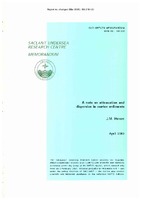| dc.contributor.author | Hovem, Jens M. | |
| dc.date.accessioned | 2018-10-11T14:06:01Z | |
| dc.date.available | 2018-10-11T14:06:01Z | |
| dc.date.issued | 1989/04 | |
| dc.identifier | 1696 | |
| dc.identifier.govdoc | SM-218 | |
| dc.identifier.uri | http://hdl.handle.net/20.500.12489/185 | |
| dc.description.abstract | From the more recent investigations reported ill the literature, | |
| dc.description.abstract | it can be concluded that solid friction appears to be of lit,tle importance for attenuation in partially and fully saturated sedilnents and that the dominating | |
| dc.description.abstract | loss mechanism is due to the flow of fluid relative to the solid. The | |
| dc.description.abstract | colnplete Biot theory describes both the loss associated with the global flow of fluid, which is dependent, on tlle permeability of the medium, and the local fluid flow caused by the opening and closing of cracks. This last contribution can be modelled by assuming a viscoelastic frame. The purpose of this note is to discuss some consequences of the theory, especially those concerning tlle frequency dependence of attenuation and sound velocity. It is demonstrated that the Biot theory does not give more velocity dispersion than expected from any causal linear systern and that it is extremely difficult to use tlle theory for predicting how the attenuation will vary with frequency. | |
| dc.format | vi, 16 p. : ill. ; 5 fig. | |
| dc.language | English | |
| dc.publisher | NATO. SACLANTCEN | |
| dc.relation.ispartofseries | ADB133609 | |
| dc.subject | Seafloor sediments | |
| dc.subject | Acoustic propagation | |
| dc.subject | Underwater acoustics | |
| dc.subject | Acoustic scattering - Seafloor and sea surface | |
| dc.title | A note on attenuation and dispersion in marine sediments | |
| dc.type | Scientific Memorandum (SM) | |
